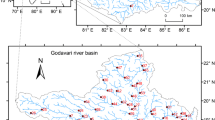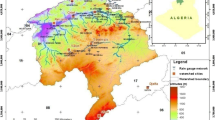Summary
A generalized method to estimate the probable maximum precipitation (PMP) has been developed for catchments in eastern India (80° E, 18° N) by pooling together all the major rainstorms that have occurred in this area. The areal raindepths of these storms are normalized for factors such as storm dew point temperature, distance of the storm from the coast, topographic effects and any intervening mountain barriers between the storm area and the moisture source. The normalized values are then applied, with appropriate adjustment factors in estimating PMP raindepths, to the Subarnarekha river catchment (upto the Chandil dam site) with an area of 5663 km2. The PMP rainfall for 1, 2 and 3 days were found to be roughly 53 cm, 78 cm and 98 cm, respectively. It is expected that the application of the generalized method proposed here will give more reliable estimates of PMP for different duration rainfall events.
Similar content being viewed by others
References
Dhar, O. N., Rakhecha, P. R., Mandal, B. N., 1977: Estimation of design storm for the subarnarekha basin upto Chandil and Ghatsila dam sites.J. Power and River Valley Devp. 27(9), 338–343.
Dhar, O. N., Rakhecha, P. R., Mandal, B. N., Sangam, R. B., 1981: The rainstorm which caused the Morvi dam disaster in August, 1979.Hydrol. Sciences Bull. 26(1, 3), 71–81.
Rakhecha, P. R., Kennedy, M. R., 1985: A generalized technique for the estimation of probable maximum precipitation in India.J. Hydrology 78, 345–359.
Rakhecha, P. R., 1986: On some hydrometeorological studies of the Indian rainfall. Ph.D. thesis, Univ. of Poona, 96–121.
Rakhecha, P. R., Deshpande, N. R., Nandargi, S. S., 1990: Maximum persisting dew points during the southwest monsoon season over India.Mausam 41(1), 140–142.
Rakhecha, P. R., Mandal, B. N., 1993: Probable maximum precipitation in northwest India—a generalized approach. Proc. Symp. on Unusual storm events and their relevance to dam safety and snow hydrology, CBIP Publ. No. 234, 89–96.
Rakhecha, P. R., Mandal, B. N., Deshpande, N. R., 1993: Unusual rainstorms and their use in the safety of dams. Proc. Symp. on Usual storm events and their relevance to dam safety and snow hydrology, CBIP Publ., No. 234, 291–300.
United States Weather Bureau (USWB), 1970: Probable maximum precipitation, MeKong River basin. USWB, Hydrometeorol. Rep. No. 46, Silver Spring Md.
World Meteorological Organization (WMO), 1969: Estimation of maximum floods.Tech. Note No. 98, WMO No. 232, TP-126, 40–41.
World Meteorological Organization (WMO), 1986: Manual for estimation of probable maximum precipitation.Operational Hydrology Report No. 1, WMO No. 332, 269 pp, Second Edition.
Author information
Authors and Affiliations
Additional information
With 5 Figures
Rights and permissions
About this article
Cite this article
Rakhecha, P.R., Mandal, B.N., Kulkarni, A.K. et al. Estimation of probable maximum precipitation for catchments in eastern India by a generalized method. Theor Appl Climatol 51, 67–74 (1995). https://doi.org/10.1007/BF00865541
Received:
Revised:
Issue Date:
DOI: https://doi.org/10.1007/BF00865541




